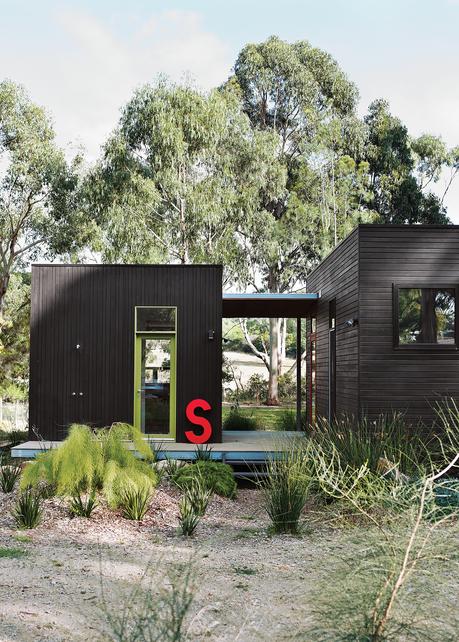 For her family’s house near Melbourne, Anna Horne created a series of prefab wood modules using a design from the company Prebuilt. She found the old industrial letter at a factory; it stands for Somerset, the name of the house. Image courtesy of Lisa Cohen.
For her family’s house near Melbourne, Anna Horne created a series of prefab wood modules using a design from the company Prebuilt. She found the old industrial letter at a factory; it stands for Somerset, the name of the house. Image courtesy of Lisa Cohen.
After outgrowing their holiday flat above a beachside cafe on the Mornington Peninsula outside Melbourne, Australia, Anna Horne and her husband, John Willems—with their two young sons, Jude and Sam, in tow—decided to purchase land nearby and install a prefab house. At the time, Horne, having trained in architecture, was working for former colleagues who had just started their own prefab company, Prebuilt. “Up until that point, there were no kit homes available in Australia with a design focus,” says Horne. “I loved that my friends’ company was breaking new ground with logical, design-based ideas. It certainly makes building more manageable—and affordable.”
 The dining room is adjacent to the open-plan living area and shares the view out over the deck and garden to bushland. Throughout the house, the floorboards are made from recycled blackbutt timber. Image courtesy of Lisa Cohen.
Horne designed the house, which consists of three modules, based on a model created by the architectural firm Pleysier Perkins for Prebuilt. Constructed in Prebuilt’s factory outside Melbourne, the house was then transported down to the sleepy seaside town of Merricks and placed within a secluded bush setting of natural grasses and tall eucalyptus trees. For the interiors, Horne found striking, red-accented Tunisian tiles and a large suzani fabric that created the foundation for her eclectic mix of color and design.
The dining room is adjacent to the open-plan living area and shares the view out over the deck and garden to bushland. Throughout the house, the floorboards are made from recycled blackbutt timber. Image courtesy of Lisa Cohen.
Horne designed the house, which consists of three modules, based on a model created by the architectural firm Pleysier Perkins for Prebuilt. Constructed in Prebuilt’s factory outside Melbourne, the house was then transported down to the sleepy seaside town of Merricks and placed within a secluded bush setting of natural grasses and tall eucalyptus trees. For the interiors, Horne found striking, red-accented Tunisian tiles and a large suzani fabric that created the foundation for her eclectic mix of color and design.
Oh! Suzani
Horne purchased the Danish rosewood dining table and the Semi Trompetpendel pendant lamp by Fog & Mørup from Angelucci. The suzani fabric stretched across the wall makes for a striking and original artwork. “I spent a long time finding the right one, as many are heavily stained because they have been used in houses and yurts before finding their way out of Uzbekistan,” says Horne. The Eames chair is from Living Edge.
In Living Color
Horne sourced the living area’s red-and-white Tunisian tiles directly from a manufacturer online. “It was the first site I looked at, the tiles were well priced, and the company was easy to deal with,” says Horne. “When I requested this specific tile in red, it just happened to be the perfect red, so I went with my gut instinct.” Against the tile background is a freestanding heater by Nectre. Horne bought the hepsi kilim on a trip to Turkey and found the large leather ottoman at a bazaar in Istanbul. The small ottoman is from Country Road.
Decked Out
The large outdoor deck is the main entertaining area and connects the separate kids’ wing to the rest of the house. Here is where Horne and Willems spend the most time with Jude, Sam, and the family dog, Sumo. “If the weather permits, we eat our meals out on the deck,” notes Horne. The powder-coated chairs are from Industria X. The Australian, plantation-grown silvertop ash cladding—dark-stained and installed horizontally—from Quantum Timber Finishes better allows the house to blend into the surrounding bush, while a lighter-stained Australian spotted gum, on the deck and on the overhead pergola, provides contrast.
Clean Lines
Located off the kids’ wing is the out- door shower, where the children rinse off after beach visits. To further offset the cladding, the architectural team alternated boards of various widths and set them on one module in a vertical formation. Horne asked for select doorways and window panes to be painted in vibrant red and apple green. “I love how these colors resonate within the space,” she says.
